The Alphacool NexXxoS Cool Answer 360 DDC/XT Liquid Cooling Kit Review
by E. Fylladitakis on October 24, 2016 9:30 AM ESTInstallation
Casual users often wonder about how much harder the installation of a kit is over a AIO solution or even an air cooler. Actually, the installation itself is not very complex – the selection of the proper parts is. As the NexXxoS Cool Answer 360 DDC/XT is a full liquid cooling kit, it gives us the chance to demonstrate the installation process and highlight some of the most critical difficulties.
The first step is to install the liquid cooling block onto the CPU. Due to the size and the design of the block, this may be a very easy process, even easier than the installation of a simple air cooler. The Alphacool XP3 Light is a very easy to install block. Once the backplate with the support screws is attached to the rear of the motherboard, the block is simply fastened on the CPU using the thumbscrews and springs.
A critical issue when selecting liquid cooling parts is the selection of a proper radiator. A larger radiator will not necessarily improve performance, especially if the pump is weak and it can easily cause compatibility issues. In our case, we do have a powerful pump and the kit is configured with maximum performance and expandability in mind, so the XT45 radiator is a judicious choice.
It is however so thick that we could not fit it even in the Phantecs Enthoo Pro, a case specifically designed to support large radiators, just because the third fan was interfering with the extruding motherboard’s heatsinks. This might not have been an issue if we simply chose another motherboard with different heatsinks/layout. When selecting a high performance radiator, it is critical to take into account both the clearance of the case and the possible interference from other hardware parts.
The joined 5.25” bay reservoir and pump assembly does increase the ease of installation significantly. A stand-alone pump and reservoir would require the user to seek his/her own mounting space and methods. The placement of a reservoir in a 5.25” bay may seem very easy and straightforward, but there is a small catch; you cannot actually access the filling hole while the reservoir is inside the bay. As the reservoir needs to be pulled at least partially outside of the case, the user needs to make sure that the tubing is long enough to allow for it. For a fully clear reservoir, it is a pity that it does not have any lighting or direct support for external lighting options. This will not be an issue in a well-lit system though.
We should note that the Repack reservoir did not actually fit into the Enthoo Pro directly, as the body of the reservoir would not fit in between the side 5.25” device support tabs of the chassis. We had to bend two of the tabs out of the way in order for the reservoir to slide into a 5.25” bay. In order to effortlessly fit into any case, it should vertically have a slightly narrower body than its front faceplate, exactly like 5.25” devices do.
Once fully assembled, the liquid cooling setup looks very tidy and futuristic, having the system standing out from the appearance of a typical PC. When everything has been double-checked and tightened well (by hand, tools will damage most of these parts), it is time to fire up the PSU and fill the system with liquid. Note that the PSU needs to be disconnected from all of the system’s devices during this process, especially the motherboard. Alphacool provides a connector for the PSU that will start it without having to connect it to a motherboard, allowing to calmly fill the kit with liquid and check for leaks. Do not attempt to fill the kit with liquid by powering on the main system even if you are certain that there are no leaks because the CPU will overheat and risk damage in a matter of a few seconds without liquid into the loop.


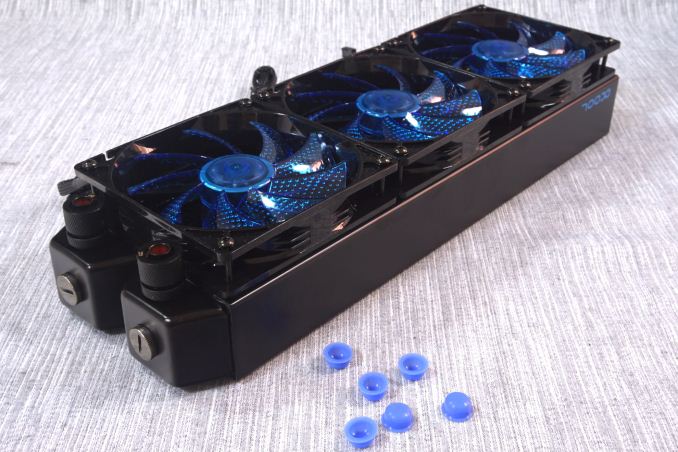
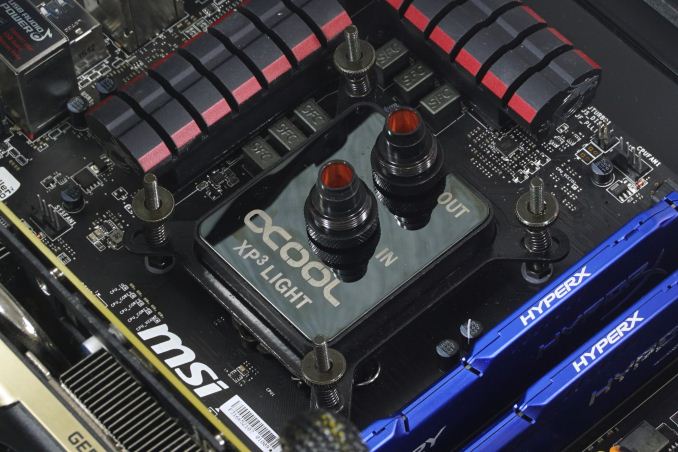
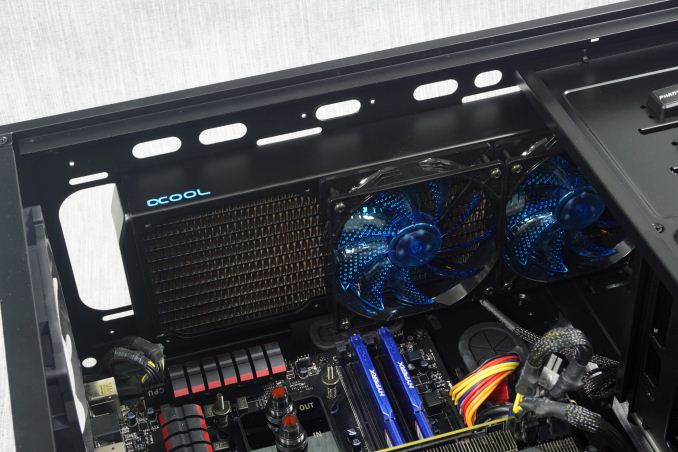
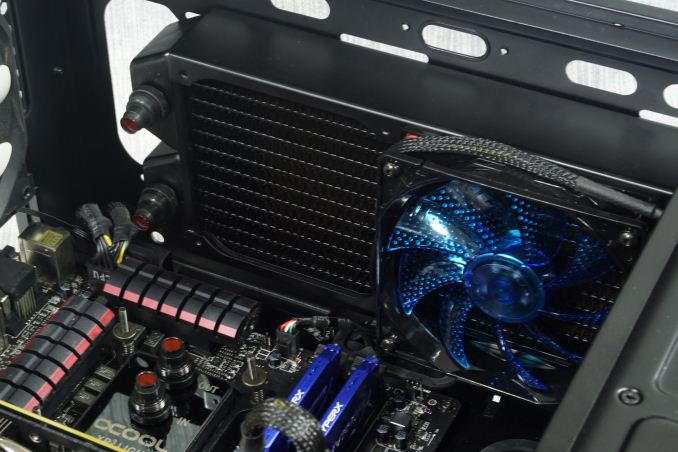
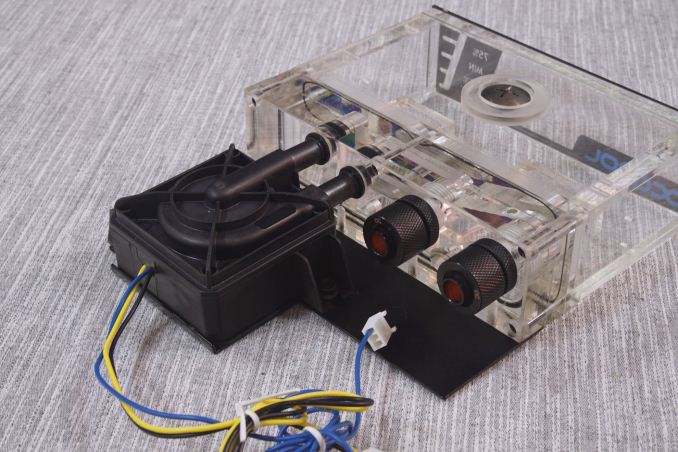
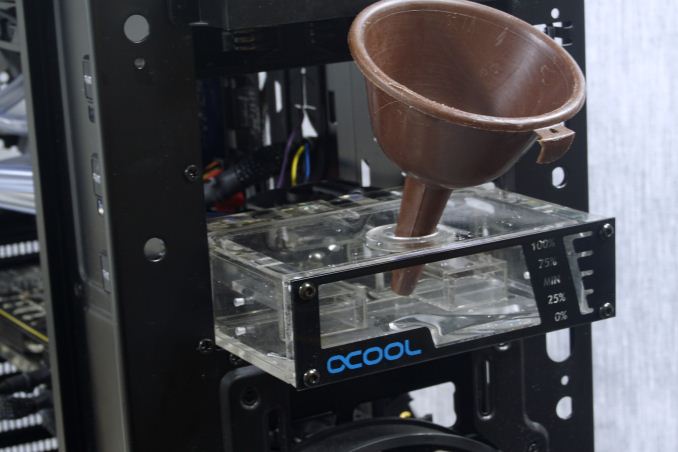









40 Comments
View All Comments
JoeyJoJo123 - Tuesday, October 25, 2016 - link
>The home user's typical workloads don't benefit from overclockingTypical home users aren't spending at least a thousand dollars on a custom built PC, and investing in the enthusiast platform (x99) as opposed to the standard desktop platform (H170).
>the increase in performance is marginal and not worth the effort.
My 6600k went from 3.5GHz to 4.6GHz after an overclock and minor overvoltage to ensure system stability. I don't think that's at all marginal. Additionally, many boards are coming with EZ Overclock modes if you invest in a K-series CPU + Z170 chipset motherboard. You go into the BIOS and select their preset. I started with Gigabyte's G5 Gaming's 6600k @ 4.4GHz preset and changed the multiplier from 44 to 46 and the core voltage up by +50mV. ASUS boards have a dynamic overclock function that goes through a series of reboots to find your processor's best overclock, which can change from chip to chip. It's nowhere near as hard as you make it out to be and a 31% increase in peak performance for the same money spent isn't as inconsequential as you make it out to be.
>Sure there's showboating to friends and emotional self-gratification, but those aren't tangible rewards.
Rewards such as going from 90 FPS min, and 130 FPS average in a game on a 144hz Freesync monitor to a 110 FPS min and 155 FPS average is an actual tangible benefit to me. In fact, that's indicative of the extra performance I got, without having to lower a single graphical setting to achieve.
>in my opinion, it's wasteful, childish, and silly.
In my opinion, it's wasteful, childish, and silly to try to force your opinion that overclocking is against your religion on an internet site full of enthusiast PC users. You're not an enthusiast PC user that likes to overclock? Fine by me. I don't go around saying that people should always buy overclockable K-series CPUs rather than settling on a basic i5 or i3, as everyone has different use-cases. But I certainly don't really care to hear from morons who say my real world gains from overclocking a $200 processor are wasteful, childish, or silly.
Just FYI, that's the pay I get from a half-day of work. Why the hell do you care if I overclock some sand made into circuits? Why do you think you have any say in how other people spend their money?
BrokenCrayons - Tuesday, October 25, 2016 - link
<...aren't spending at least a thousand dollars...>Typical home users really do drop over 1K on their computers. It's a lot more common than you might think. I'm surprised you'd open this post with a claim about costs and then make a counter-point using a diametrically opposed perspective at the end of it.
<...went from 3.5GHz to 4.6GHz...>
The numeric value of the overclock isn't the focal point of that argument. There are a lot of other factors that contribute to a computer's capabilities. Your word processor and e-mail fetching won't dramatically change due to your efforts. Games, though entertainment and not particularly important, won't see benefits either even with very high end graphics cards as AT's recent benchmarks analyzing CPU performance have previously proven. So yes, I still feel it's not consequential and certainly not worth the effort.
<...going from 90 FPS min, and 130 FPS...>
I highly doubt there's a situation in which a framerate increase of the numbers you're expressing reasonably results solely from overclocking a CPU in the scenario you're describing.
<...don't really care to hear from morons who say...>
I'm not forcing my opinion on anyone. No one is being chained to their chair and made to read, think about, or respond to my comments. If my comments encourage the occasional person to think about computing and put it into a different perspective, then I'm happy to have done so. If that requires they go through a little discomfort during that self-analysis wherein they redirect their anguish at me in the form of name-calling, then so be it. However, that portion of your post does support my comment about how childish these sorts of things become and the sorts of people attracted to such ideas. I imagine you weren't setting out to support that portion of my argument, but I'd be remiss were I not to point it out.
<...the pay I get from a half-day of work...>
Cleverly using a response to hint at your personal wealth. Hmm...interesting.
kn00tcn - Wednesday, October 26, 2016 - link
you highly doubt there's an fps situation!? what's your problem, crysis1 for example is known to top out around 80fps on all modern gfx cards due to cpu limits that only a cpu overclock can increaseall game benchmarks that have an amd cpu against an intel cpu clearly show a drop in fps (if not average then it's the minimum) on the same gfx card
all the people talking of 60hz or 'a 1070 is overkill for 1080p' completely ignore 120+
all the singlethreaded software alone is being gimped on the more expensive platforms since those cpus are lower blocked than the regular consumer ones, so overclocking is the only way to have more cores AND stay at 4ghz
fanofanand - Tuesday, October 25, 2016 - link
Other than the minor insults and bragging about your income, this was an excellent rebuttal. I would like to see more of this type of debate/discussion. :)kn00tcn - Wednesday, October 26, 2016 - link
winningalso one key thing about E series, they are usually clocked much lower, meaning single thread performance drops, affecting tons of use cases
Death666Angel - Tuesday, October 25, 2016 - link
"but in my opinion, it's wasteful, childish, and silly."And there you lost all credibility in this discussion.
BrokenCrayons - Tuesday, October 25, 2016 - link
<And there you lost all credibility in this discussion.>Why would anyone worry about establishing credibility in a comments section under an article about a computer water cooling system? Of all the things in life there are to worry about, that seems pretty insignificant. It's a bit like worrying about what your friends think of the color of crayon you used on the birthday card you made for your parent in elementary school art class. :)
Andrew LB - Wednesday, February 8, 2017 - link
I have a roughly 30% overclock on my graphics card that is water cooled and it results in an FPS gain from 35-40 to a nice solid 60fps locked. Interesting how the moment someone makes a point which refutes your claims, out comes the condescending attitude and insults. The sign of someone who lost the argument.Samus - Monday, October 24, 2016 - link
Using a dielectric liquid helps mitigate risk of a leak, as does occasional maintenance. Just like a car, and speaking from experience, a liquid cooler leak is generally slow and can be caught before damage is done. The only time I've had a leak was after getting back from a LAN party where my case was being transported and the next morning I noticed my carpet was wet (the system had been on all night)One of the fittings was just a little lose and needed to be tightened. I lost about 60ml of coolant and it trickled over my videocard and motherboard to the bottom of my case. Since I use an inert coolant and wetter water as a deox no damage was done.
Achaios - Tuesday, October 25, 2016 - link
Ι agree with BrokenCrayons. Not to mention that squeezing more performance out of CPU's above a certain point easily achievable by Air Coolers is meaningless after 2011 and the introduction of the i5-2500k.Only component worth of liquid cooling is the GPU IMO.